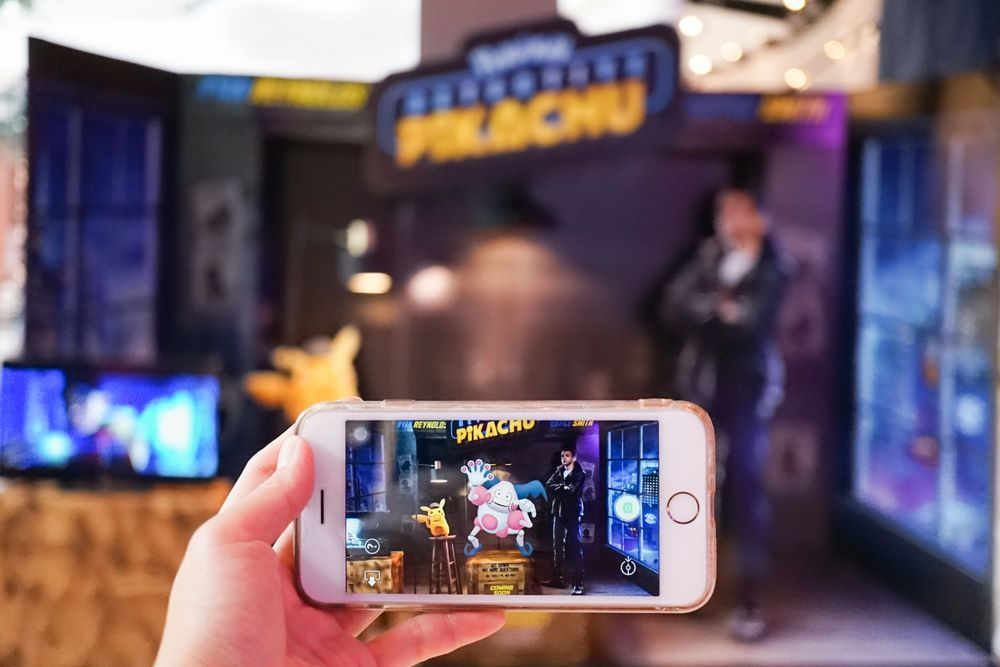The journey of augmented reality (AR) from a once lofty science-fiction notion to a reality grounded in scientific principles is remarkable.
The costs associated with AR were prohibitively high, making it a distant dream for designers to incorporate into their projects. Fast forward to today, and augmented reality has become accessible even on mobile handsets. This transformative shift signifies that design for augmented reality is no longer limited to a select few; it has become a viable option for UX designers of all backgrounds and sizes.
In essence, augmented reality development provides an enhanced view of the actual, physical world, where elements are enriched by computer-generated inputs. These inputs span a spectrum, including sound, video, graphics, GPS overlays, and more.
Initially, the concept of augmented reality dates back to Frank L. Baum’s 1901 novel, where electronic glasses mapped data onto people, referred to as a “character marker.” What was once a speculative science-fiction idea has evolved into a tangible and practical reality in contemporary times.
Immersive technologies offer designers an expansive canvas to craft experiences that seamlessly merge the digital and physical realms, delivering captivating, intuitive encounters.
Augmented Reality (AR): Bridging Realities
AR enriches our perception of reality by overlaying digital content onto the physical world, introducing contextual information and interactive elements.
Whether enabling virtual product try-ons in retail or integrating directions into navigation apps, AR transforms how we engage with information and surroundings. UX designers play a pivotal role in ensuring that AR experiences blend digital content seamlessly with real-world contexts.
Virtual Reality (VR): Designing Alternate Realities
VR, on the other hand, transports users to entirely virtual environments, providing immersive experiences that engage multiple senses. From immersive gaming adventures to virtual tours of distant locations, VR offers unparalleled engagement potential. In UX design for VR, considerations include creating intuitive navigation, mitigating motion sickness, and prioritizing user comfort.
Designing for AR and VR: Key Considerations
- Contextual Awareness: In the realm of user experience design, contextual awareness involves creating interfaces or experiences that dynamically respond to the user’s environment, circumstances, or specific conditions.
This understanding extends beyond the immediate user inputs and takes into account factors.
Designing with contextual awareness in mind ensures that the user experience remains relevant, efficient, and tailored to the user’s needs within their specific context, providing a more personalized and adaptive interaction.
- User Interaction: User Interaction in the realms of Augmented Reality (AR) and Virtual Reality (VR) necessitates seamless and intuitive engagement. From responsive gestures and voice commands to tactile haptic feedback, designing interfaces that intuitively align with users’ actions ensures. A natural and immersive interaction, enhancing the overall user experience within these dynamic and immersive environments.
- Information Hierarchy: Maintaining a clear Information Hierarchy is paramount in both Augmented Reality (AR) and Virtual Reality (VR) experiences. The challenge lies in presenting information concisely and contextually relevant, striking a balance that avoids overwhelming users while ensuring that key details are easily accessible
This thoughtful design approach enhances user understanding and engagement in these technologically enriched environments.
- Navigation and Wayfinding: Navigation and Wayfinding take center stage in both Augmented Reality (AR) and Virtual Reality (VR), serving as essential elements that guide users through immersive experiences.
Providing clear cues and robust wayfinding systems is crucial in these dynamic environments, ensuring users can effortlessly navigate
Thoughtful design in this realm not only enhances user orientation but also contributes significantly to the overall effectiveness and user satisfaction within AR and VR interactions.
- Motion and Animation: Motion and Animation: Motion and Animation play a pivotal role in both Augmented Reality (AR) and Virtual Reality (VR) experiences, requiring a delicate balance to achieve seamless transitions without inducing discomfort.
Any Animation studio can integral in this process, as they bring the technical expertise and creative vision necessary.
Well-thought design considerations in managing the pace and fluidity of motion elements contribute to a more immersive user journey. Within these dynamic environments, enhancing the overall quality and enjoyability of AR and VR interactions.
The Future of UX Design: Mixing Realities
As AR and VR technologies mature, UX designers are poised to lead the charge in creating immersive and impactful experiences. From education and healthcare to entertainment and e-commerce, these technologies offer vast applications.
To stay abreast of trends and best practices in AR and VR design is crucial for UX professionals. As embracing these tools opens new realms of creativity and innovation, transforming the way users interact with digital content and experiences. Let’s embark on this journey to blend realities, redefining user experiences and unlocking doors to unparalleled creativity and innovation.
Also read: The Evolution and Future of App Development




stromectol price – covid ivermectin brand carbamazepine 400mg
order accutane for sale – dexona over the counter linezolid 600mg us
purchase amoxicillin pills – valsartan 80mg brand buy generic ipratropium 100mcg
zithromax buy online – tinidazole 300mg generic purchase bystolic sale
omnacortil order – cheap prednisolone progesterone 200mg price
purchase lasix online cheap – buy nootropil without a prescription betamethasone 20 gm cost
augmentin 375mg over the counter – buy ketoconazole without prescription order duloxetine sale
doxycycline price – buy glucotrol 5mg generic glipizide 5mg price
buy augmentin 375mg for sale – brand augmentin cymbalta usa
order rybelsus online cheap – cost vardenafil 20mg purchase cyproheptadine pill
buy zanaflex sale – tizanidine 2mg tablet buy hydrochlorothiazide cheap
buy cialis 40mg for sale – brand cialis pills brand sildenafil
cost of viagra 100mg – purchase viagra sale buy cialis 10mg online
order atorvastatin generic – buy atorvastatin 10mg online order lisinopril 10mg
cenforce 100mg cheap – order cenforce for sale glycomet 1000mg cheap
omeprazole 10mg us – metoprolol tablet buy atenolol 100mg pill
depo-medrol without prescription – buy methylprednisolone sale aristocort oral
desloratadine pill – cost loratadine 10mg order dapoxetine 90mg generic
cheap cytotec – diltiazem 180mg us purchase diltiazem generic
order acyclovir 400mg pill – order allopurinol for sale buy crestor without prescription
buy domperidone 10mg generic – purchase motilium generic flexeril online order
order domperidone – cost sumycin 500mg order flexeril 15mg pill
purchase inderal online cheap – buy inderal 10mg online methotrexate price
buy warfarin 2mg generic – metoclopramide online buy hyzaar order online
order levofloxacin for sale – cost levaquin 500mg buy zantac
buy esomeprazole 40mg generic – buy topiramate 200mg pill buy imitrex generic
meloxicam cheap – buy celebrex for sale order flomax 0.2mg without prescription
buy ondansetron paypal – order zofran 4mg online cheap zocor ca
buy valacyclovir medication – propecia order online buy generic forcan
modafinil 100mg cost purchase modafinil purchase provigil pills modafinil canada buy modafinil tablets purchase modafinil online cheap buy provigil 100mg pill
I couldn’t turn down commenting. Well written!
Greetings! Extremely productive suggestion within this article! It’s the scarcely changes which choice obtain the largest changes. Thanks a lot for sharing!
purchase azithromycin online cheap – buy azithromycin pill flagyl 400mg canada
cost semaglutide 14 mg – cyproheptadine order online purchase periactin pills
domperidone pills – order domperidone generic buy flexeril pills
where to buy inderal without a prescription – methotrexate generic order methotrexate 2.5mg online
cost amoxicillin – cheap amoxicillin without prescription buy combivent 100 mcg pill
buy azithromycin online cheap – tinidazole 300mg brand buy nebivolol cheap
augmentin 375mg pill – atbioinfo buy generic ampicillin
cheap nexium 20mg – anexamate buy nexium paypal
order coumadin 5mg online cheap – cou mamide cozaar 50mg pill
mobic us – https://moboxsin.com/ meloxicam 15mg sale
order deltasone 10mg pills – aprep lson order prednisone 10mg generic
over the counter erectile dysfunction pills – fastedtotake.com ed remedies
amoxicillin over the counter – combamoxi buy amoxil generic
diflucan where to buy – https://gpdifluca.com/ purchase fluconazole pills
cenforce 50mg us – https://cenforcers.com/# brand cenforce 100mg
cialis 5mg daily – click tadalafil professional review
buy zantac 150mg pill – brand ranitidine 300mg order zantac without prescription
best price cialis supper active – click maxim peptide tadalafil citrate
More posts like this would add up to the online elbow-room more useful. https://gnolvade.com/
cheap viagra now mastercard – viagra cheap overnight dapoxetine 60 mg sildenafil 100mg
This is a question which is forthcoming to my callousness… Myriad thanks! Unerringly where can I find the contact details in the course of questions? amoxicillin usa
I’ll certainly bring to be familiar with more. this
I couldn’t resist commenting. Well written! https://prohnrg.com/product/orlistat-pills-di/
More content pieces like this would create the интернет better. combien coГ»te le viagra professional
This website positively has all of the information and facts I needed to this subject and didn’t know who to ask. https://ondactone.com/product/domperidone/
More articles like this would frame the blogosphere richer.
https://doxycyclinege.com/pro/celecoxib/